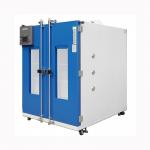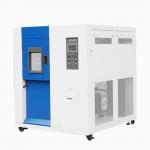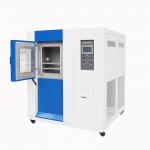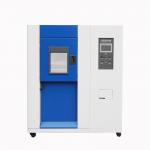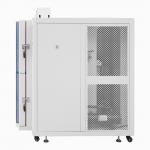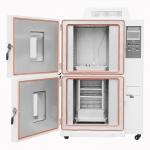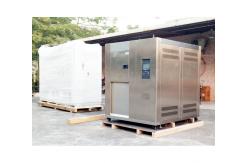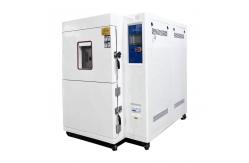In the fast-paced and highly competitive industrial landscape, the
need for comprehensive and accurate product testing has become an
absolute necessity. The Large Three-slot Cold and Hot Temperature
Thermal Shock Test Chamber Customized stands as a pinnacle of
innovation, offering a bespoke solution for industries that demand
the utmost in thermal shock testing capabilities. This state-of-the-art test chamber, with its unique three-slot
design and customizable features, is engineered to subject products
and components to rapid and extreme cold and hot temperature
fluctuations. It caters to a diverse range of industries, including
aerospace, automotive, electronics, and telecommunications. The
primary objective is to evaluate how items will endure the stress
of sudden and severe thermal transitions, replicating the harsh
conditions they might encounter during manufacturing,
transportation, or in-service operation. By providing a highly
accurate and realistic simulation of such environments,
manufacturers and researchers can identify potential weaknesses,
optimize product designs, and ensure strict compliance with
industry standards and regulations. - Sturdy and Versatile Construction
- The chamber is constructed with a heavy-duty framework, typically
fabricated from high-strength alloy steel, to withstand the rigors
of continuous thermal shock testing. The exterior is designed to be
both durable and aesthetically pleasing, with a finish that can
resist scratches and corrosion. The interior of each slot is lined
with a non-reactive and smooth surface, such as stainless steel or
a specialized thermal-resistant polymer, to prevent any interaction
between the chamber and the tested specimens. The three-slot
configuration allows for multiple samples or different test setups
to be run simultaneously, enhancing testing efficiency and
flexibility. The doors of the slots are engineered for a perfect
seal, featuring advanced locking mechanisms and heavy-duty gaskets.
They also include large viewing windows, made of tempered glass
with anti-fog and anti-scratch coatings, enabling clear visual
monitoring of the testing process without disturbing the internal
temperature gradients.
- Precision Temperature Control Systems
- Cold Temperature Zone: The cold temperature system is highly
efficient and can reach extremely low temperatures, often down to
-80°C or even lower, with an accuracy of ±0.3°C. It utilizes
advanced refrigeration technologies, such as cascade refrigeration
with environmentally friendly refrigerants, along with a
sophisticated temperature control loop and multiple strategically
placed temperature sensors. This ensures rapid and uniform cooling
of the samples, essential for effective cold shock testing. The
system also incorporates built-in safety features to prevent
overcooling and protect both the samples and the chamber
components.
- Hot Temperature Zone: The hot temperature system is equally
impressive, capable of achieving high temperatures up to +200°C or
more, with an accuracy of ±0.3°C. It employs high-quality heating
elements and a precise temperature control mechanism. The chamber
is equipped with a powerful circulation fan to ensure even heat
distribution throughout the slots. Similar to the cold temperature
system, it has safety features to avoid overheating and safeguard
the integrity of the testing environment.
- Temperature Transition: The hallmark of this chamber is its
remarkable ability to transition between cold and hot temperatures
at a rapid rate. The temperature change rate can be as fast as 20°C
to 30°C per minute, allowing for a highly realistic simulation of
extreme thermal cycling. The control panel, which is user-friendly
and intuitive, enables users to program and adjust complex
temperature profiles, including the duration of each temperature
stage, the number of cycles, and the rate of temperature change.
- Advanced Instrumentation and Data Acquisition
- The chamber is outfitted with a comprehensive suite of sensors.
Temperature sensors are distributed throughout each slot to monitor
the temperature at different locations, ensuring that the samples
experience the desired temperature conditions uniformly. These
sensors are connected to a state-of-the-art data acquisition system
that records and stores all the temperature data. The data can be
accessed and analyzed in real-time or retrieved later for in-depth
studies. The data acquisition system is highly flexible and can be
integrated with external software and databases, facilitating
seamless data transfer and analysis. It can also be configured to
send notifications and reports automatically, saving time and
effort for the users. Additionally, the control panel includes
built-in alarms and safety features that alert users in case of any
abnormal temperature conditions, power failures, or equipment
malfunctions.
- Volume and Dimensions: With a generous volume, this large chamber is designed to
accommodate a wide variety of sample sizes and shapes. The interior
volume of each slot is carefully optimized to ensure efficient air
circulation and temperature distribution. The external dimensions
are configured to fit within a standard industrial or laboratory
space, taking into account factors such as access, ventilation, and
clearance. Typically, the chamber may have a width of around 150 to
200 centimeters, a depth of 120 to 150 centimeters, and a height of
200 to 250 centimeters, depending on the specific customization
requirements.
- Temperature Uniformity: The temperature uniformity within each slot is maintained within
±0.5°C during both cold and hot temperature conditions. This
ensures that all parts of the tested samples are exposed to a
consistent thermal environment, which is crucial for obtaining
accurate and reliable test results.
- Temperature Stability: Both the cold and hot temperature systems offer excellent
temperature stability, with minimal fluctuations over time. This
allows for repeatable and comparable testing, enabling
manufacturers to make informed decisions about product improvements
based on consistent data.
- Temperature Change Rate: The chamber can achieve a rapid temperature change rate,
typically ranging from 20°C to 30°C per minute, depending on the
specific settings and the thermal load of the samples. This fast
transition capability is essential for simulating real-world
scenarios where products may be exposed to sudden and extreme
temperature changes.
- Accurate Simulation of Severe Thermal Environments
- The primary function of this chamber is to provide a highly
accurate and realistic simulation of cold and hot temperature shock
conditions. By precisely controlling the temperature transitions,
it allows users to evaluate how products and components will behave
in various thermal stress situations. For example, in the aerospace
industry, it can test the performance of avionics systems, engine
components, and structural materials under the extreme temperature
changes that occur during flight. In the electronics industry, it
can assess the durability of circuit boards, microchips, and
connectors under rapid temperature fluctuations.
- The ability to program complex temperature profiles, including
multiple cycles of cold and hot temperature shock, is also a
valuable function. This can help in uncovering potential weaknesses
or failure points in products that may not be evident under static
temperature testing. For instance, a product that functions well at
a constant temperature may develop cracks or experience performance
degradation after several cycles of thermal shock, and this chamber
can accurately replicate such scenarios.
- Enhanced Product Quality and Research Capabilities
- Through comprehensive testing in the chamber, manufacturers can
identify and address potential issues in their products. If a
product shows signs of degradation or failure under specific
thermal shock conditions, appropriate measures can be taken, such
as modifying the design, changing the material composition, or
improving the manufacturing process. This leads to the development
of more stable and reliable products, reducing the risk of failures
and recalls. In the research field, it allows for the exploration
of new materials and the understanding of their properties under
extreme thermal cycling, which can lead to significant scientific
breakthroughs.
|
